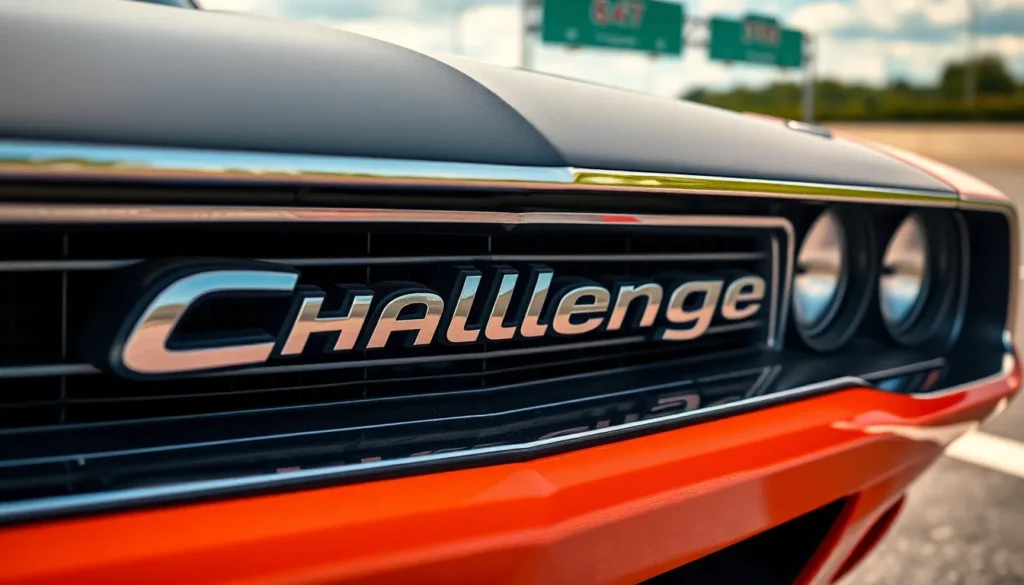The Dodge Challenger logo isn’t just a badge—it’s a symbol of American muscle car heritage that’s evolved alongside one of Detroit’s most iconic vehicles. We’ve watched this emblem transform from its debut in 1970 to today’s modern interpretations while maintaining its core identity as a mark of raw power and performance.
From the classic shield design to contemporary variations, the Challenger’s logo tells a story of automotive evolution and brand loyalty. We’ll explore how Dodge has masterfully balanced tradition with innovation through subtle design changes that honor the car’s legendary status while appealing to new generations of enthusiasts.
Whether you’re a longtime Mopar fan or simply curious about automotive branding, understanding the Challenger logo’s significance reveals deeper insights into American car culture. We’re diving into the design elements symbols and cultural impact that make this emblem instantly recognizable on streets and racetracks worldwide.
The Evolution of the Dodge Challenger Logo Through the Decades
The Dodge Challenger logo has undergone remarkable transformations since its debut, reflecting both automotive design trends and the brand’s commitment to performance heritage. We’ve witnessed these changes mirror the car’s own journey through different eras of American muscle car culture.
Original 1970 Challenger Emblem Design
Bold lettering defined the original Challenger logo, featuring a distinctive script font that emphasized speed and power. The 1970 emblem showcased silver chrome lettering against black backgrounds, creating maximum contrast for visibility and impact.
Horizontal orientation dominated the badge placement, stretching across the rear deck lid and grille areas to emphasize the car’s wide, aggressive stance. Chrome finish materials reflected the premium quality expectations of muscle car enthusiasts during this golden era.
Geometric simplicity characterized the foundational design, avoiding complex graphics in favor of clean, readable typography that conveyed confidence and American automotive pride. This minimalist approach helped establish instant brand recognition among competing muscle cars.
Modern Revival Logo Changes Since 2008
Three dimensional effects transformed the contemporary Challenger logo, incorporating shadowing and depth elements that weren’t possible with original manufacturing techniques. We see metallic finishes and subtle gradients replacing the flat chrome appearance of vintage badges.
Digital integration capabilities expanded logo applications, allowing for illuminated versions, dashboard displays, and multimedia presentations that connect with modern technology expectations. Color variations now include red, silver, and black combinations depending on trim levels.
Refined typography maintains classic proportions while improving readability across different sizes and viewing distances. The modern script preserves the original’s muscular character but adds precision and consistency that meets current design standards.
Special Edition Badge Variations
SRT performance models feature unique logo treatments, incorporating specialized fonts, distinctive colors, and additional design elements that distinguish high performance variants from standard Challenger models. These badges often include model exact designations like “Hellcat” or “Demon” integrated into the primary logo design.
Anniversary editions showcase commemorative styling, with special finishes, unique color combinations, and limited production numbering that appeals to collectors and enthusiasts. The 50th anniversary models featured gold accents and vintage inspired typography combinations.
Racing heritage badges incorporate checkered flag motifs, performance callouts, and track inspired design elements that connect the street car to Dodge’s motorsports achievements. These variations often appear on interior trim pieces, steering wheels, and exterior accent locations beyond traditional badge placement areas.
Understanding the Iconic Design Elements of the Dodge Challenger Logo
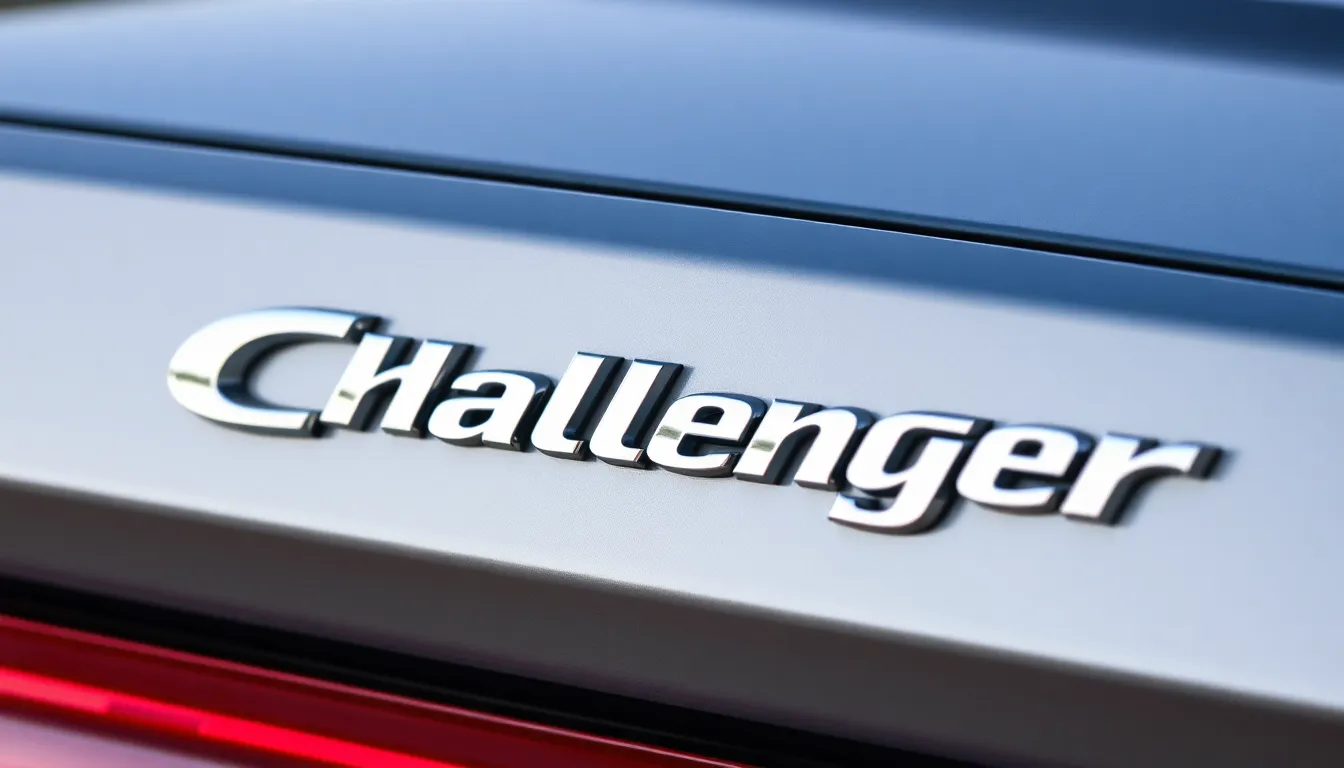
We examine the core design elements that make the Challenger logo instantly recognizable across automotive enthusiasts worldwide. These fundamental components work together to create a visual identity that perfectly captures the essence of American muscle car performance.
The Distinctive Font Typography and Lettering
Bold lettering serves as the cornerstone of the Challenger logo’s visual impact, utilizing a custom script font that conveys both speed and strength. We notice how the letters feature angular edges and ever-changing slopes that mirror the aggressive stance of the vehicle itself. Each character flows seamlessly into the next, creating a sense of motion even when stationary.
Custom typography differentiates the Challenger from other automotive brands through its unique character spacing and proportions. The font maintains consistent thickness throughout each letter while incorporating subtle variations that add visual interest. We observe that the “C” and “R” letters receive particular emphasis through extended flourishes that enhance the logo’s premium appearance.
Script styling creates an unmistakable connection to classic American automotive design from the muscle car era. The letterforms blend traditional calligraphy influences with modern geometric precision. We find that this combination appeals to both vintage car enthusiasts who appreciate historical design elements and younger audiences drawn to contemporary aesthetics.
Color Schemes and Their Symbolic Meanings
Metallic silver represents the premium quality and craftsmanship associated with performance vehicles, reflecting light in ways that suggest speed and sophistication. We use this primary color to establish the logo’s connection to automotive excellence and engineering precision. Chrome finishes amplify this effect by creating mirror like surfaces that catch attention from multiple viewing angles.
Deep black provides contrast and depth while symbolizing power, mystery, and the serious performance capabilities of Challenger models. We incorporate black elements to ground the design and create visual hierarchy within the logo composition. This color choice reinforces the aggressive nature of the muscle car while maintaining elegance and refinement.
Red accents appear in special edition variations to communicate passion, energy, and racing heritage connections that define the brand’s motorsports involvement. We apply red strategically to highlight exact model designations or anniversary celebrations. Blood red tones specifically evoke the adrenaline and excitement associated with high performance driving experiences.
Integration with the Dodge Brand Identity
Ram head imagery occasionally appears alongside Challenger lettering to strengthen brand recognition and connect the model to Dodge’s broader automotive portfolio. We position these elements to complement rather than compete with the primary Challenger script. The combination creates a cohesive brand experience that reinforces customer loyalty across multiple vehicle categories.
Consistent proportions ensure the Challenger logo maintains proper scale relationships when displayed with other Dodge branding elements on vehicles, marketing materials, and digital platforms. We maintain exact size ratios that preserve readability and visual impact across different applications. These standards guarantee brand consistency whether the logo appears on a key fob or a billboard advertisement.
Shared design language connects the Challenger logo to Dodge’s overall brand architecture through similar font weights, color palettes, and styling approaches used across the entire vehicle lineup. We carry out common design principles that create family resemblance while allowing each model to maintain its distinct personality. This approach strengthens brand recognition while celebrating individual model characteristics that appeal to exact customer segments.
Comparing Dodge Challenger Logo Variations Across Different Models
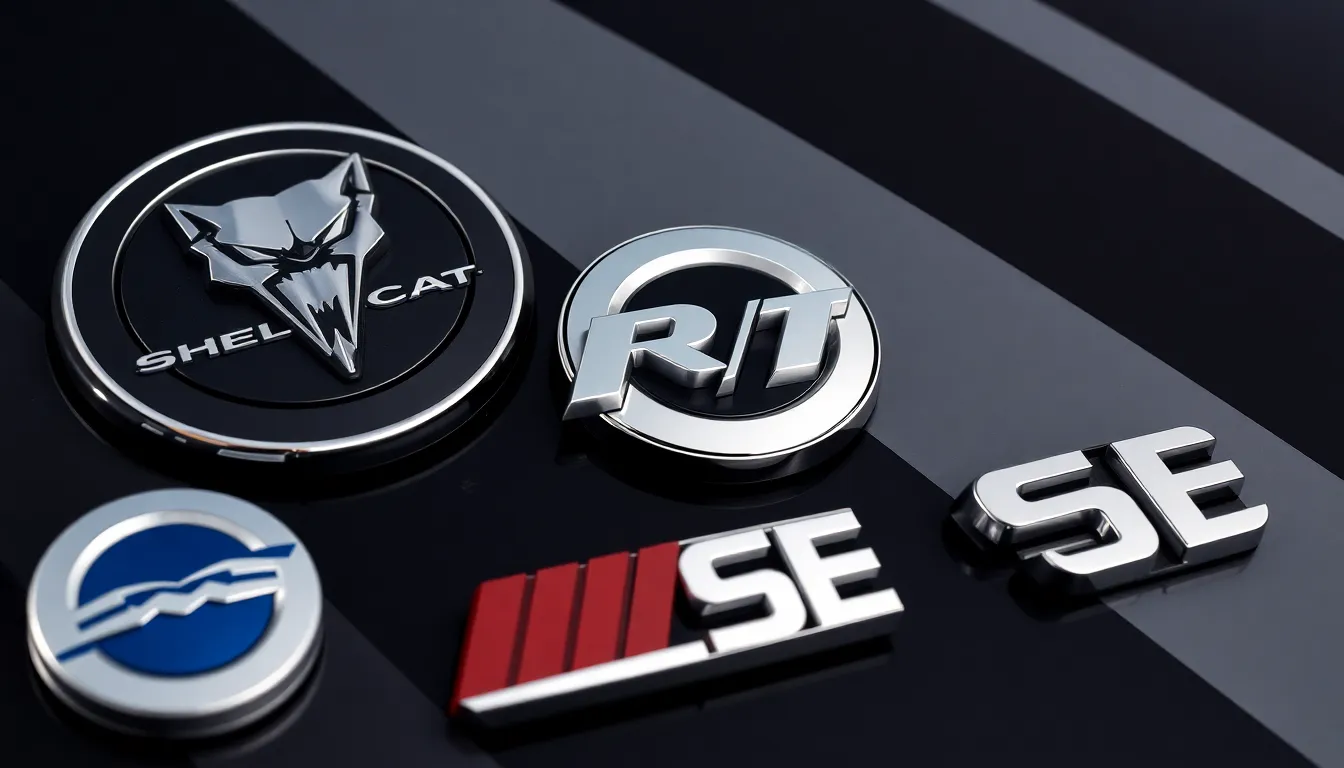
Different Challenger models showcase distinct logo treatments that reflect their performance capabilities and target audiences. We’ll examine how these badge variations communicate each model’s unique character while maintaining brand consistency.
SRT Hellcat Badge Design Features
SRT Hellcat emblems feature aggressive demonic cat head imagery that immediately signals extreme performance. The menacing feline silhouette appears in matte black finish with red accents on key details like the eyes and inner mouth. Badge placement occurs prominently on the front grille and rear deck lid for maximum visibility.
Dimensional elements include raised surfaces that create shadow effects under different lighting conditions. The Hellcat head measures approximately 4.5 inches in width when mounted on the grille. Text integration combines “SRT” lettering above the cat imagery with “HELLCAT” script below in matching font styling.
Special finishing treatments use brushed aluminum backgrounds on premium trim levels. Hood badges receive additional clear coat protection to prevent fade damage from engine heat exposure. Quarter panel emblems feature smaller 2.8 inch versions that maintain proportional balance with body lines.
R/T Logo Specifications and Placement
R/T badge designs emphasize racing heritage through bold block lettering and circular background elements. The classic treatment features white letters on black circular backgrounds measuring 3.2 inches in diameter. Modern interpretations add chrome rings around the perimeter for enhanced visibility.
Placement locations include front fender positions just behind the wheel wells and rear deck lid centering. Side marker integration occurs on door panels for certain model years. Grille mounting provides additional brand recognition from frontal viewing angles.
Font specifications use condensed sans serif typefaces that maximize letter size within circular constraints. Letter spacing maintains consistent gaps of 0.15 inches between characters. Color combinations vary between silver on black for base models and gold on black for anniversary editions.
Standard SE Model Emblems
SE model badges focus on elegant simplicity through understated chrome lettering and minimal decorative elements. The standard treatment features raised chrome letters spelling “CHALLENGER” across the rear deck lid. Font selection emphasizes readability over aggressive styling cues.
Size dimensions measure 12 inches in total length for rear deck applications and 6 inches for side panel placements. Letter height maintains 1.5 inch consistency across all characters. Chrome finish provides mirror like reflection that enhances premium appearance.
Positioning standards place rear emblems 4 inches above the license plate mounting area. Front grille badges appear within the crosshair design element for integrated appearance. Side emblems align with door handle height for visual balance with body proportions.
Where to Find the Dodge Challenger Logo on Your Vehicle
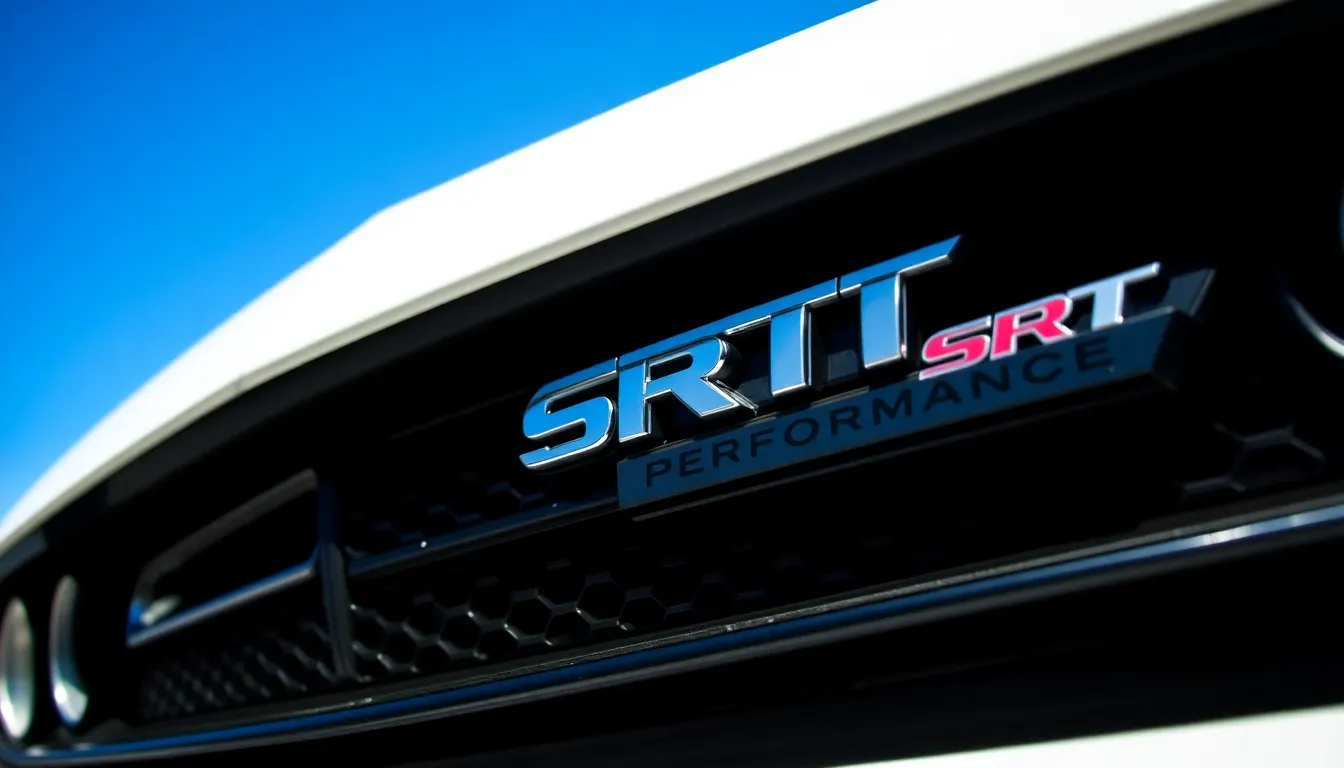
Identifying Challenger emblems on your muscle car involves knowing their strategic placement locations throughout the vehicle’s exterior and interior surfaces.
Front Grille Placement and Sizing
Front grille positioning centers the primary Dodge Challenger logo prominently within the honeycomb mesh design. Most 2015-2023 models feature a chrome-finished emblem measuring approximately 4.5 inches in width positioned directly in the middle crossbar area.
Upper grille sections on SRT models often display additional performance badges measuring 2.8 inches wide. These smaller emblems complement the main logo while highlighting the vehicle’s enhanced capabilities.
Lower air intake areas sometimes showcase model-exact badges like “R/T” or “SXT” positioned on either side of the central opening. Each badge measures roughly 3.2 inches in length and uses raised lettering for enhanced visibility.
Rear Trunk Lid Positioning
Trunk lid centers display the most prominent rear-facing Challenger logo measuring 5.1 inches across. This location provides maximum visibility for following vehicles while maintaining the car’s aggressive stance.
Model designation badges appear below the main emblem on the right side of the trunk lid. Common placements include “SRT,” “Hellcat,” or displacement indicators like “6.4L” positioned approximately 8 inches from the rear edge.
Left side positioning typically features engine specification badges or special edition markers. These emblems measure between 2.5-3.8 inches and use chrome or black finishes depending on the trim level.
Interior Dashboard and Steering Wheel Locations
Steering wheel centers showcase circular Challenger emblems measuring 2.1 inches in diameter. Modern models feature illuminated versions that glow when the ignition activates, creating an enhanced driving experience.
Dashboard panels display smaller logo variations near the passenger airbag cover or instrument cluster housing. These locations measure approximately 1.8 inches wide and use subtle chrome or silver finishes.
Door sill plates feature elongated Challenger script logos that measure 6.3 inches in length. Each plate illuminates when doors open, welcoming occupants with branded lighting effects that reinforce the vehicle’s premium positioning.
Aftermarket Dodge Challenger Logo Options and Customizations

We’ve explored the factory Challenger emblems, but aftermarket customizations offer exciting opportunities to personalize your muscle car’s appearance.
LED Illuminated Badge Upgrades
LED illuminated badges transform your Challenger logo into a striking nighttime display feature. These electric upgrades typically use low-voltage LED strips integrated behind translucent emblem faces, creating an impressive glow effect that enhances visibility after dark. Installation requires basic wiring skills and connects to your vehicle’s existing electrical system through the parking light circuit.
Popular illuminated options include front grille badges that project the Challenger script in crisp white or amber lighting. Manufacturers like Putco and Recon offer plug-and-play kits designed specifically for Challenger applications, ensuring proper fit and weather resistance. These upgrades cost between $80-200 depending on complexity and feature waterproof housings that withstand harsh driving conditions.
Carbon Fiber and Chrome Replacement Options
Carbon fiber emblems provide a modern racing aesthetic while reducing weight compared to traditional metal badges. These lightweight alternatives feature genuine carbon fiber weave patterns sealed under clear protective coatings, delivering authentic motorsports appearance that complements performance modifications. Companies like Mopar and American Car Create produce precision-cut carbon fiber Challenger badges that maintain factory mounting points.
Chrome replacement options range from brushed aluminum finishes to black chrome treatments that offer subtle luxury appeal. Stainless steel variants resist corrosion better than factory chrome while providing mirror-like finishes that complement polished wheels and trim pieces. These premium materials typically cost $50-150 per emblem and require careful installation to prevent scratching during mounting.
Custom Color and Finish Alternatives
Custom color emblems allow complete personalization of your Challenger’s badge appearance through specialized coating processes. Powder coating techniques enable virtually any color match, including matte finishes, metallic flakes, and even color-changing chameleon effects that shift hues based on viewing angles. Professional coating services can match exact paint codes or create unique custom combinations.
Vinyl wrap overlays offer temporary customization options without permanent modifications to factory emblems. These thin adhesive films come in hundreds of colors and textures, including carbon fiber patterns, brushed metal looks, and high-gloss finishes. Installation takes minutes using basic hand tools, and removal leaves no residue when done properly within the recommended timeframe of 2-3 years.
Maintaining and Replacing Your Dodge Challenger Logo

Keeping your Challenger’s emblems in pristine condition preserves the vehicle’s visual impact and resale value. We’ll guide you through essential maintenance practices and replacement considerations for your Dodge Challenger logo.
Proper Cleaning Techniques for Logo Longevity
Gentle soap answers work best for regular emblem cleaning. Mix warm water with mild automotive soap to create a safe cleaning mixture that won’t damage chrome or painted finishes. Apply the solution using a soft microfiber cloth, working in circular motions to remove dirt and grime buildup.
Avoid harsh chemicals that can strip protective coatings. Products containing ammonia, bleach, or abrasive compounds will damage metallic finishes and fade colored emblems. Instead, use specialized automotive cleaners designed for chrome and painted surfaces.
Soft bristle brushes reach intricate logo details effectively. Old toothbrushes or detailing brushes help clean around raised lettering and complex badge designs without scratching delicate surfaces. Work gently around edges and recessed areas where debris commonly accumulates.
Dry thoroughly after each cleaning session. Water spots and mineral deposits can permanently stain chrome emblems if left to air dry. Use clean microfiber towels to pat dry all surfaces, then apply automotive wax for added protection against environmental elements.
When to Replace Worn or Damaged Emblems
Fading becomes noticeable after five to seven years of sun exposure. UV rays break down paint pigments and protective coatings, causing logos to lose their original vibrant appearance. Red accent colors typically fade first, followed by black lettering on chrome backgrounds.
Physical damage requires immediate replacement for safety reasons. Cracked or loose emblems can detach while driving, creating road hazards for other vehicles. Sharp edges from damaged badges also pose injury risks during routine maintenance or washing.
Chrome pitting indicates advanced corrosion that can’t be reversed. Small pits in metallic finishes allow moisture penetration that accelerates deterioration. Once pitting begins, the emblem will continue degrading even though regular maintenance efforts.
Theft recovery situations necessitate complete badge replacement. Unfortunately, Challenger emblems are popular targets for theft due to their distinctive design and resale value. Filing insurance claims and replacing stolen badges helps maintain your vehicle’s authentic appearance.
Professional Installation vs DIY Methods
Professional installation guarantees proper alignment and adhesion. Automotive technicians have specialized tools and experience to position emblems correctly, ensuring they remain securely attached for years. They also understand temperature requirements for optimal adhesive bonding.
DIY replacement saves money but requires careful preparation. Clean the mounting surface thoroughly with isopropyl alcohol to remove all residue from the previous emblem. Allow surfaces to dry completely before applying new badges to ensure maximum adhesive strength.
Heat application improves adhesive bonding for self installation. Use a hair dryer to warm both the emblem backing and vehicle surface before positioning. This activates adhesive compounds and creates stronger initial bonds that resist temperature cycling.
Alignment guides prevent costly positioning mistakes. Create paper templates or use masking tape to mark proper emblem placement before removing adhesive backing. Measure distances from reference points like panel edges or existing badges to maintain factory specifications.
The Cultural Impact of the Dodge Challenger Logo in Automotive History
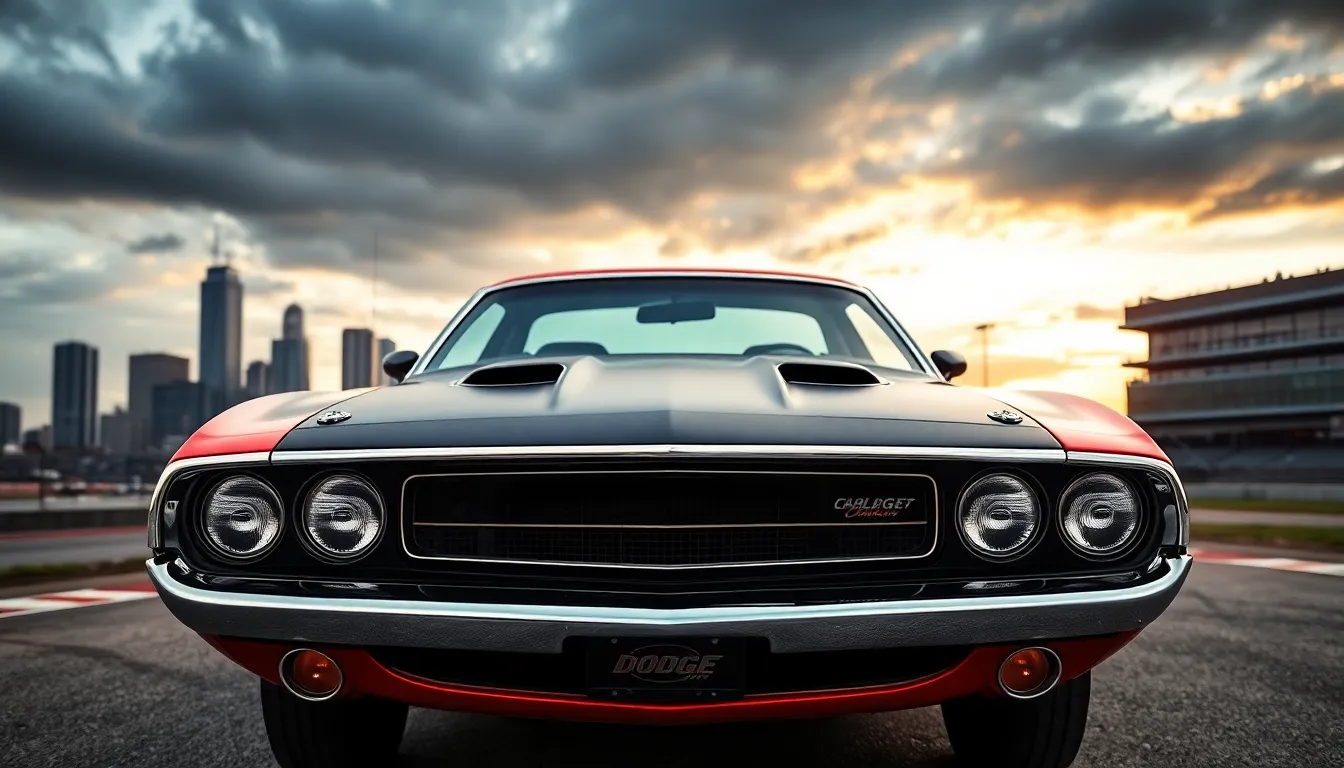
The Dodge Challenger logo transcends mere automotive branding to become a cultural touchstone in American automotive history. We examine how this iconic emblem shaped muscle car culture and influenced generations of enthusiasts worldwide.
Muscle Car Era Significance
Defining the golden age of American performance, the Challenger logo emerged as a symbol of rebellion and power during the late 1960s and early 1970s. We recognize its role in establishing the visual language that would define an entire generation of muscle cars.
Performance enthusiasts immediately connected the bold lettering with raw horsepower and street credibility. Racing legends like Richard Petty and Don Prudhomme helped cement the logo’s reputation on tracks across America, creating lasting associations between the emblem and championship victories.
Manufacturing excellence became synonymous with the Challenger badge during this era, as Dodge produced some of the most coveted performance vehicles in automotive history. Models like the 1970 Challenger R/T 440 Six Pack and the legendary Hemi variants carried the logo with pride, establishing benchmarks that modern vehicles still strive to match.
Cultural movements of the 1970s adopted the Challenger logo as a symbol of American ingenuity and freedom. Street racing communities, custom car builders, and performance shops all recognized the emblem as representing the pinnacle of domestic automotive achievement.
Pop Culture and Movie Appearances
Hollywood productions have consistently featured the Challenger logo as shorthand for American automotive power and attitude. We’ve witnessed its prominent display in films like “Vanishing Point” (1971), where the white 1970 Challenger became an automotive icon that defined car chase cinema.
Television shows regularly showcase Challenger emblems to convey character traits and storylines. Popular series like “The Fast and the Furious” franchise have featured multiple Challenger variants, each prominently displaying the logo to communicate speed, power, and American muscle heritage.
Music videos from rock and country artists frequently incorporate Challenger badges to reinforce themes of freedom and rebellion. Artists like Kid Rock, Toby Keith, and various metal bands have used the logo’s visual impact to complement their musical messages about American pride and automotive passion.
Advertising campaigns beyond Dodge have referenced the Challenger logo’s cultural significance, demonstrating its broader recognition in American consumer consciousness. Brands from fashion to electronics have borrowed visual elements from the emblem to communicate strength and reliability.
Collector Value and Recognition
Auction results consistently demonstrate the premium value that original Challenger logos command in the collector market. We track authentic 1970-1974 emblems selling for hundreds of dollars, with rare variants like Hemi badges reaching four-figure prices at specialized auctions.
Authentication experts have developed sophisticated methods for verifying original Challenger logos due to their high collector value. Key indicators include exact casting marks, font variations, and mounting hardware that distinguish genuine period pieces from reproduction items.
Restoration specialists prioritize maintaining original logos during classic Challenger rebuilds, often spending important resources to preserve or properly restore these emblems. Concours judges specifically evaluate logo authenticity and condition when scoring vehicles at prestigious shows like Carlisle Events and the Muscle Car and Corvette Nationals.
Investment potential continues growing for vehicles with original, unmolested Challenger logos in excellent condition. Classic car appraisers consistently note that authentic emblems significantly impact overall vehicle valuations, with perfectly preserved examples commanding premium prices that reflect their cultural and historical importance.
Conclusion
The Dodge Challenger logo stands as one of automotive history’s most enduring symbols of American muscle car culture. We’ve seen how this iconic emblem has evolved from its bold 1970 origins to today’s sophisticated three-dimensional designs while never losing its core identity of power and performance.
Whether you’re drawn to the aggressive SRT Hellcat badge or prefer the classic elegance of original emblems the Challenger logo continues to command respect on roads worldwide. Its strategic placement thoughtful design elements and cultural significance make it instantly recognizable to enthusiasts and casual observers alike.
For owners looking to personalize their vehicles the wealth of aftermarket options ensures everyone can find the perfect expression of their individual style. Remember that proper maintenance and authentic replacement parts help preserve both the logo’s visual impact and your vehicle’s long-term value in the collector market.
Frequently Asked Questions
What makes the Dodge Challenger logo unique among muscle car emblems?
The Dodge Challenger logo stands out through its distinctive script font with angular edges and flowing characters that create a sense of motion. Its bold typography, combined with metallic finishes and three-dimensional effects, conveys power and speed. The integration of Ram head imagery alongside the lettering reinforces brand recognition while maintaining the car’s individual identity within Dodge’s lineup.
How has the Challenger logo evolved since 1970?
The original 1970 Challenger emblem featured bold lettering with a chrome finish emphasizing premium quality. Since the 2008 revival, the logo has incorporated modern three-dimensional effects, metallic finishes, and digital integration capabilities. While maintaining its core identity, the design has adapted to contemporary standards with enhanced visibility and adaptability across different platforms and media.
What are the different Challenger logo variations across models?
Different Challenger models feature distinct badge treatments reflecting their performance capabilities. The SRT Hellcat badge includes aggressive demonic cat head imagery, the R/T logo emphasizes racing heritage with bold block lettering, and standard SE models feature elegant, simplified emblems. Special edition models often include commemorative styling and unique anniversary badges connecting to racing heritage.
Where can I find the Challenger logo on my vehicle?
The Challenger logo appears in multiple strategic locations including the prominent front grille position, rear trunk lid, side fender badges, and various interior locations. Inside the vehicle, you’ll find emblems on the dashboard, steering wheel, door sills, and seat headrests. Each placement is sized appropriately for visibility while maintaining the overall design aesthetic of the vehicle.
Can I customize or replace my Challenger logo with aftermarket options?
Yes, numerous aftermarket customization options exist including LED illuminated badges for enhanced nighttime visibility, carbon fiber and chrome replacement emblems, and custom color finishes. You can choose from professional installation or DIY methods. When replacing, ensure proper alignment and adhesion, and consider that modifications may affect resale value and warranty coverage.
How do I properly maintain my Challenger logo?
Regular cleaning with gentle soap solutions and soft brushes prevents damage to the emblem’s finish. Avoid harsh chemicals or abrasive materials that could scratch the surface. Replace logos showing signs of fading, physical damage, or chrome pitting to maintain your vehicle’s appearance and resale value. Professional cleaning products designed for automotive emblems work best for preservation.
What is the collector value of original Challenger logos?
Original Challenger logos, especially from early production years, hold significant collector value due to their historical importance and rarity. Authentication involves examining manufacturing marks, materials, and design details. Well-preserved original emblems can significantly impact vehicle valuations during restorations, making proper maintenance and documentation crucial for collectors and enthusiasts seeking authenticity.
What cultural significance does the Challenger logo hold?
The Challenger logo symbolizes American muscle car heritage and represents rebellion and power from the late 1960s muscle car era. It’s associated with racing legends and cultural movements representing American ingenuity and freedom. The logo has appeared in numerous films, music, and advertising campaigns, cementing its place in automotive history and popular culture.

